The Divi Button Module
How to add, configure and customize the Divi button module.
The Divi Button Module is a versatile module that can be used all across your website. Create fun hover styles, use custom icons, and guide your visitors through your website with the interactive button module.
View A Live Demo Of This Module
How to Add the Divi Button Module to Your Page
Before you can add the Divi Button module to your website, you’ll need to have the Divi theme installed on your WordPress website. Learn how to install the Divi theme on your WordPress website here. Once you have the Divi theme installed and activated, we can begin using the features and functionalities of Divi.
Add a Page and Load the Divi Builder
To get started, add a new page to your website. By default, the Standard Gutenberg Editor loads whenever a new post or page is added in WordPress. To load the Divi builder on any post or page, click the purple button underneath the page title that says “Use The Divi Builder”.

Once clicked, this will reload the page with the Divi Visual Builder. As your page reloads, you’ll notice three options that come up: Build From Scratch, Choose A Premade Layout, and Clone An Existing Page.
Build From Scratch
This option loads the Divi Builder with a blank page design. Choose this option if you’d like to start your page design from scratch.
Choose a Premade Layout
This option allows you to choose from our large library of pre-designed Divi layouts. You can choose from premade layouts by Divi, pre-made layouts you’ve designed and saved to your Divi Library, and existing pages on your website that you can clone.
Clone an Existing Page
This option allows you to copy another page design on your website and use it for the page you’re editing. Select this option if you’d like to load an exact copy of an existing page that you’ve already designed on your website.
Select, Build From Scratch.

Add The Divi Button Module
When you load the Visual Builder, Divi automatically adds a section and a row. You can learn more about how to modify and customize sections here and rows here. Once the section, row, and columns are set up, click on the grey “+” icon inside the row. This brings up the Divi Module Library which contains all the modules included with the Divi theme. Scroll down to “Video” and click on it to load the module.
Note: This module library is also searchable. Type the name of the module you want in the search bar at the top.
All Divi Button Module Options Explained
Once you’ve added the Button module, the module settings automatically pop up. This is where all of the content and design styles for this module are configured. These settings are organized into three groups via the tabs at the top of the module: Content, Design, and Advanced.
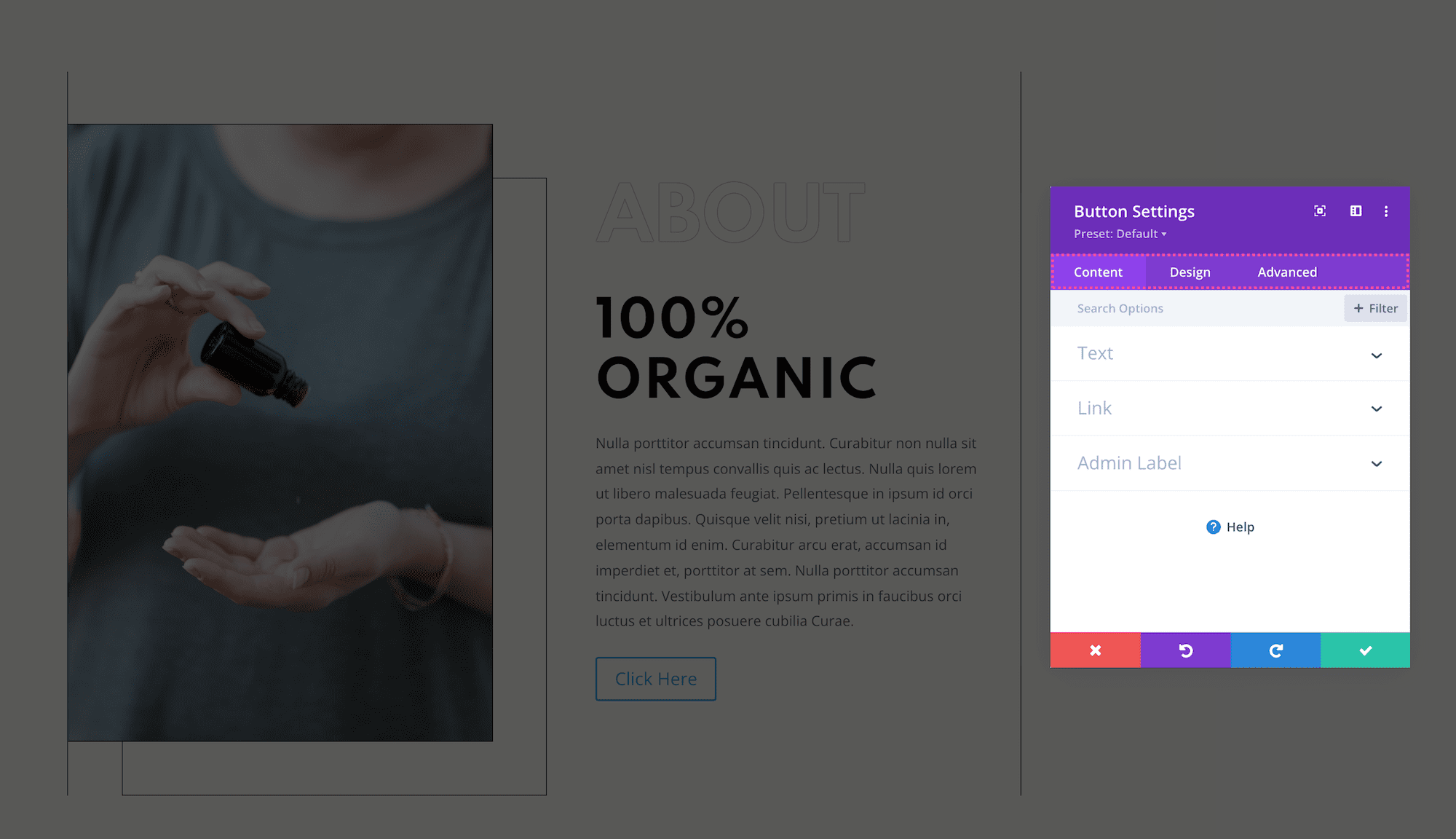
Content
Inside this tab, you’ll find the content options available for the Divi Button module.
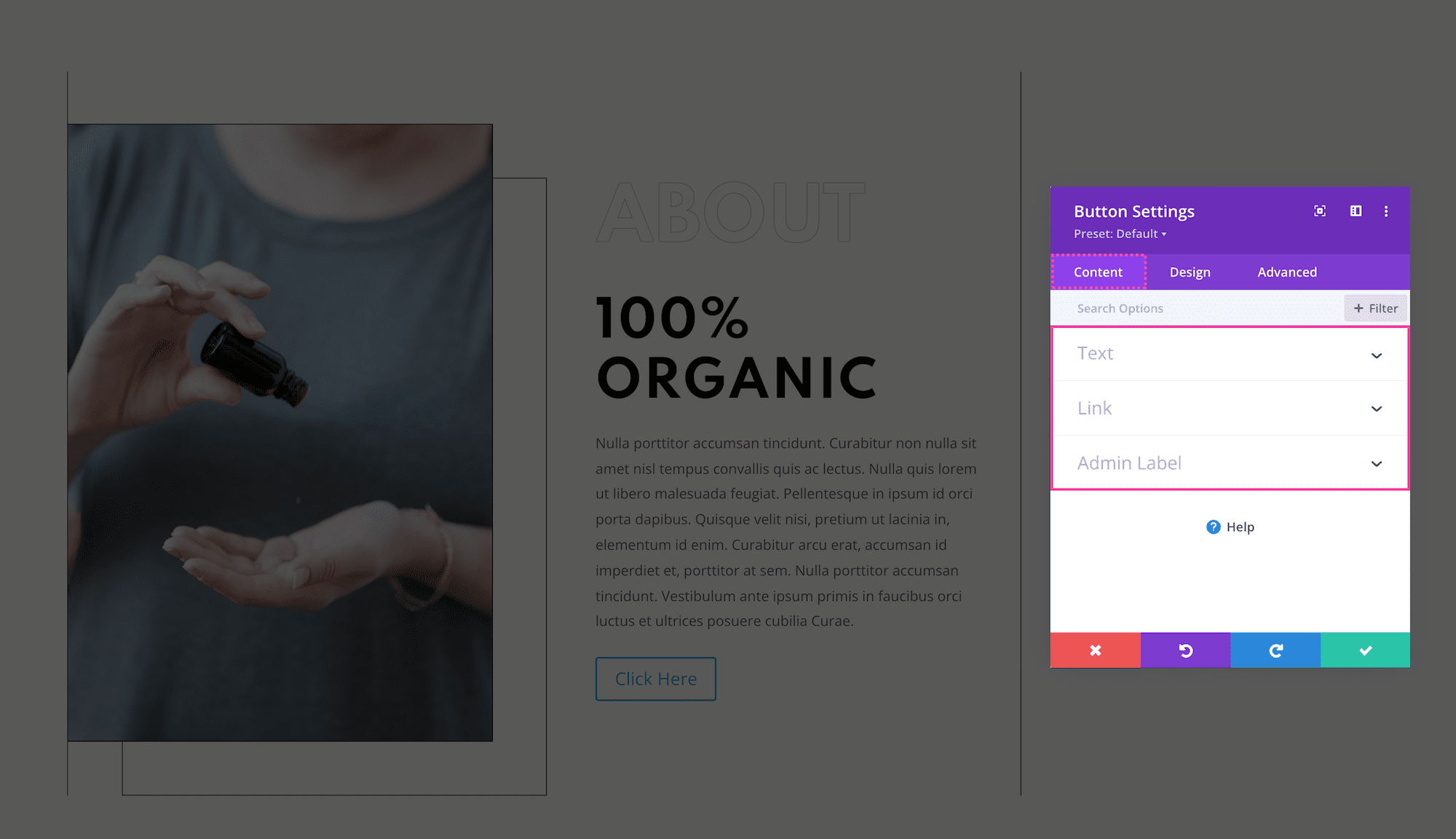
Text
- Button – Type the text you’d like the button to display here.
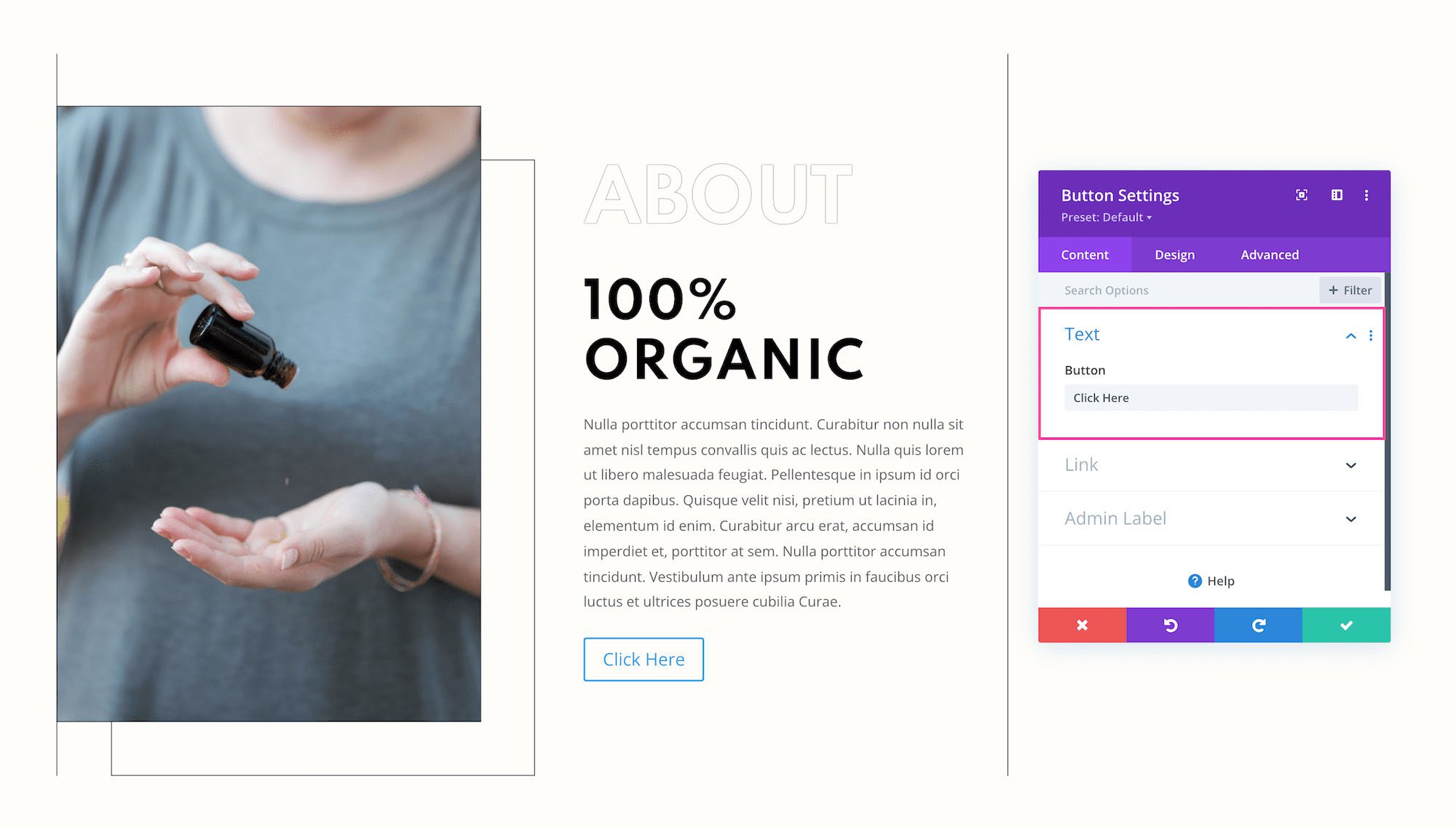
Link
This is where you paste the URL link you’d like the button to point towards.
- Button Link URL – Paste the URL of the link you would like to apply to the button here. When clicked, visitors will be taken to that web link.
- Button Link Target – Defining a link target determines whether the link, when clicked, opens in a new tab or in the same window. Choose “In The Same Window” if you want the link to open in the same window and click “In The New Tab” if you would like that link to open in a new tab. By default, “In The Same Window” is selected.
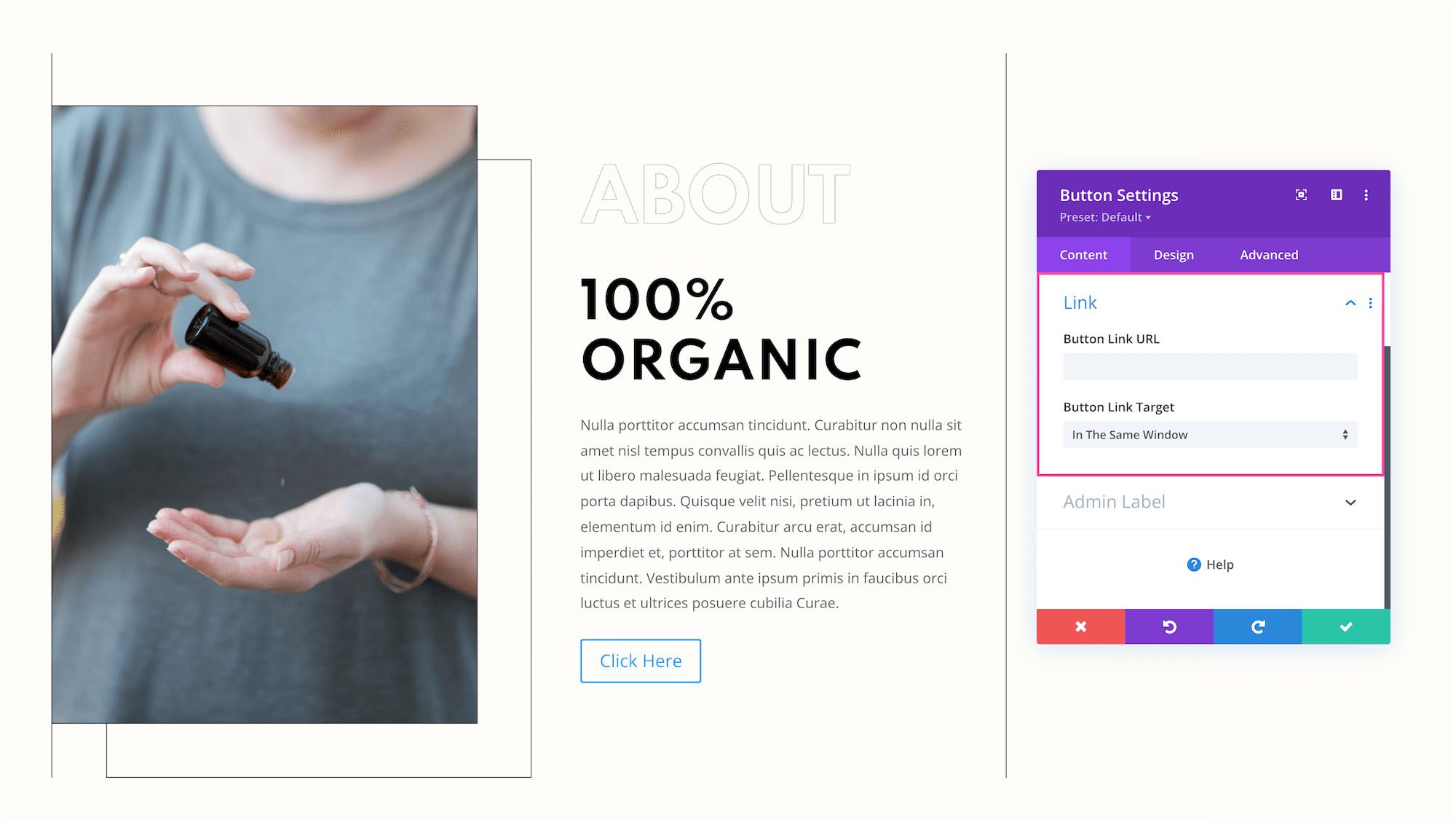
Admin Label
The Admin Label is where you can give the module a name only visible to you in order to assist in keeping things organized and easy to understand on the back end. By default, the admin label will be the name of the module. You can change the text of the admin label to reflect what you’d like.
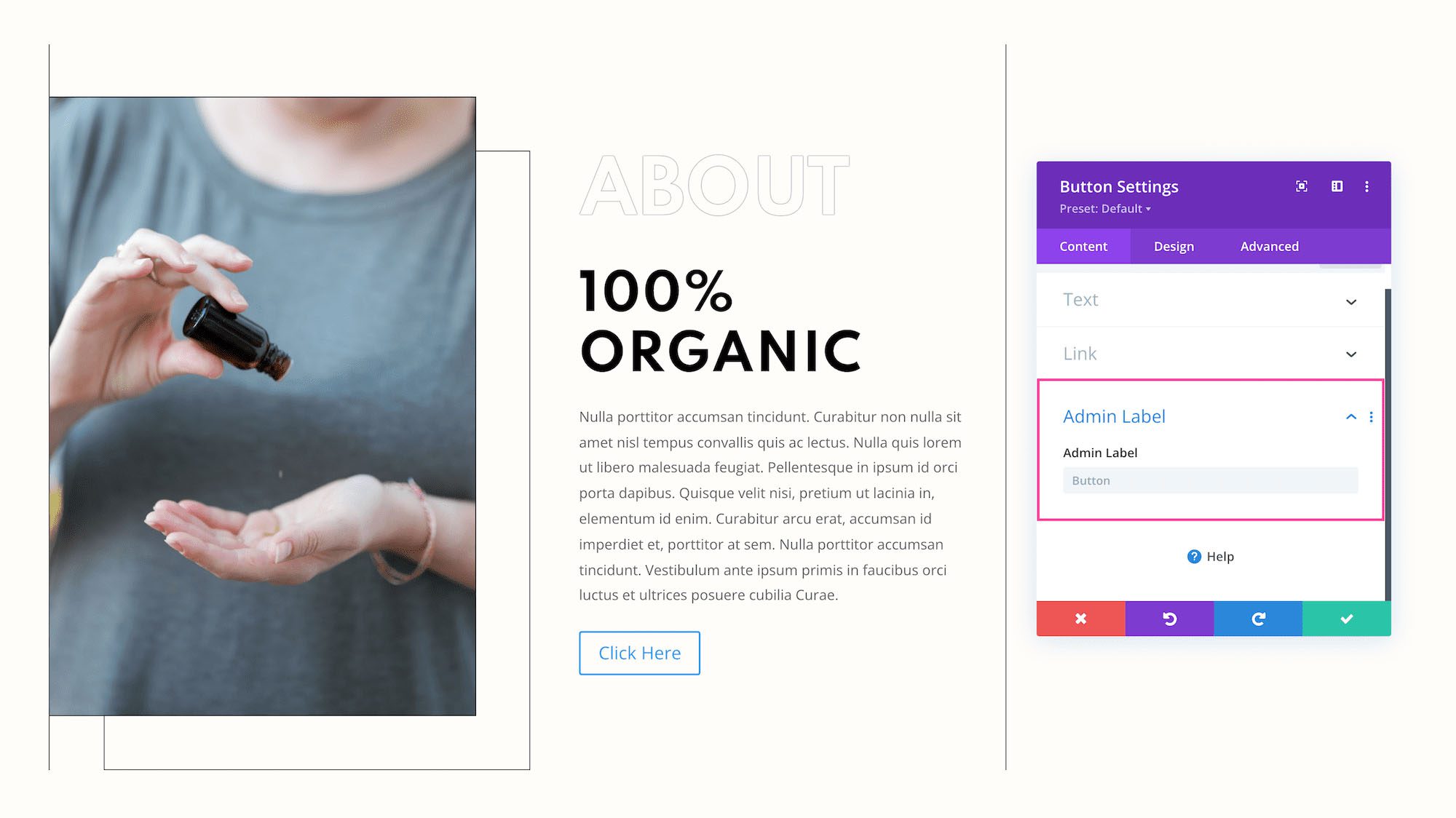
Design
Inside this tab, you’ll find all the design styles and options for the Divi Button module.
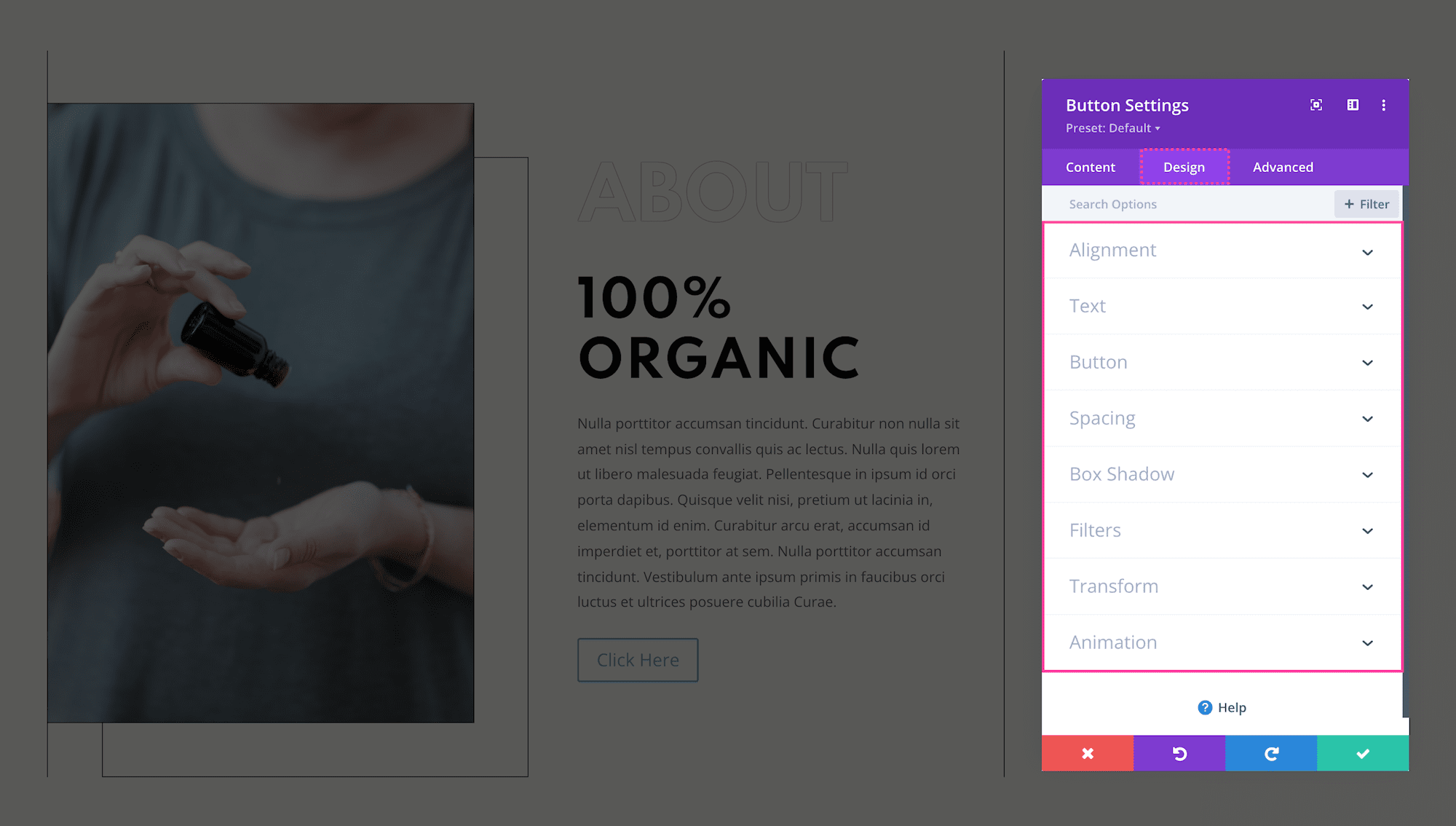
Alignment
- Button Alignment – Choose how you’d like the button to align: to the left, center, or right.
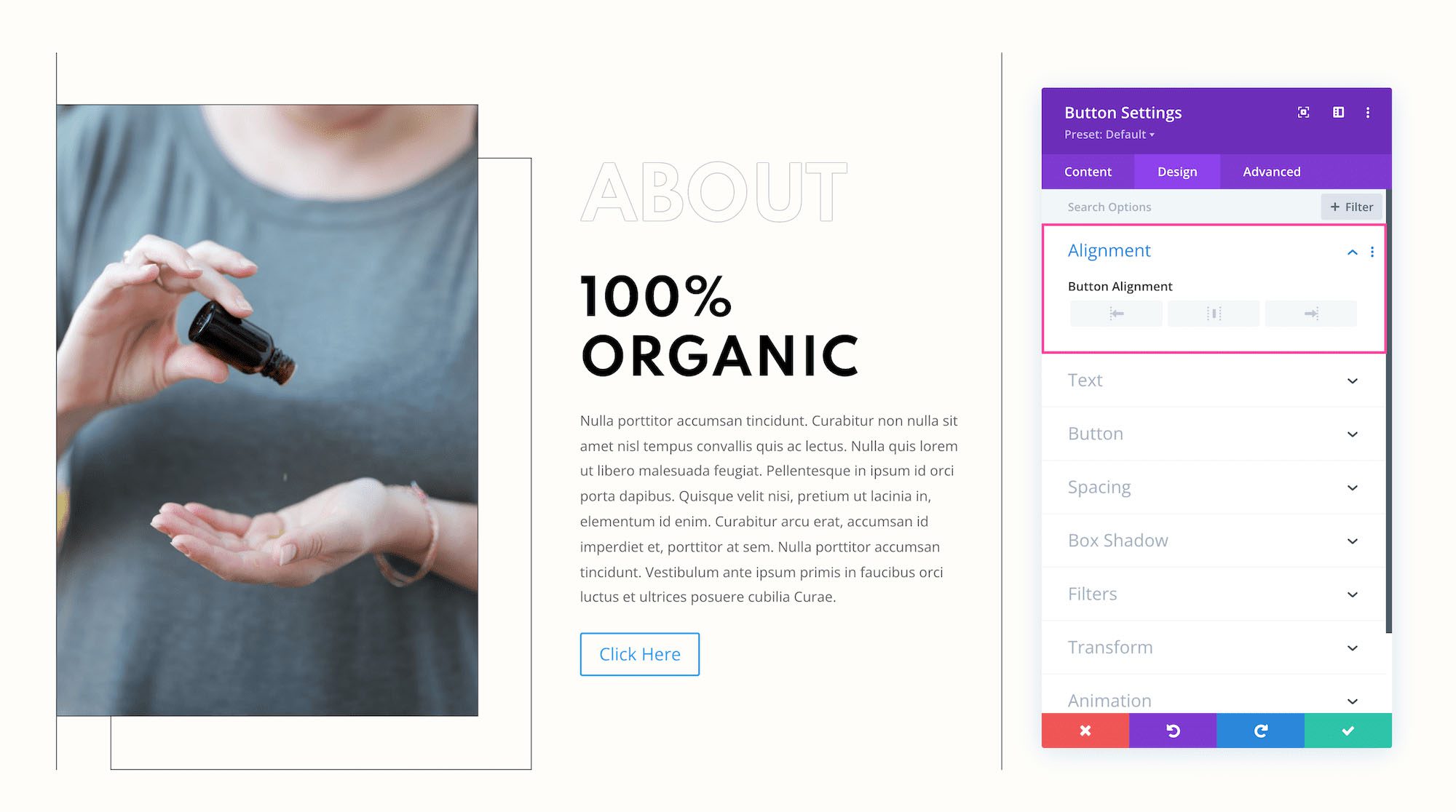
Text
- Text Color – Select the default text color palette for this module: light or dark. The default light color palette and dark color palettes can be configured in the Divi Theme Options.
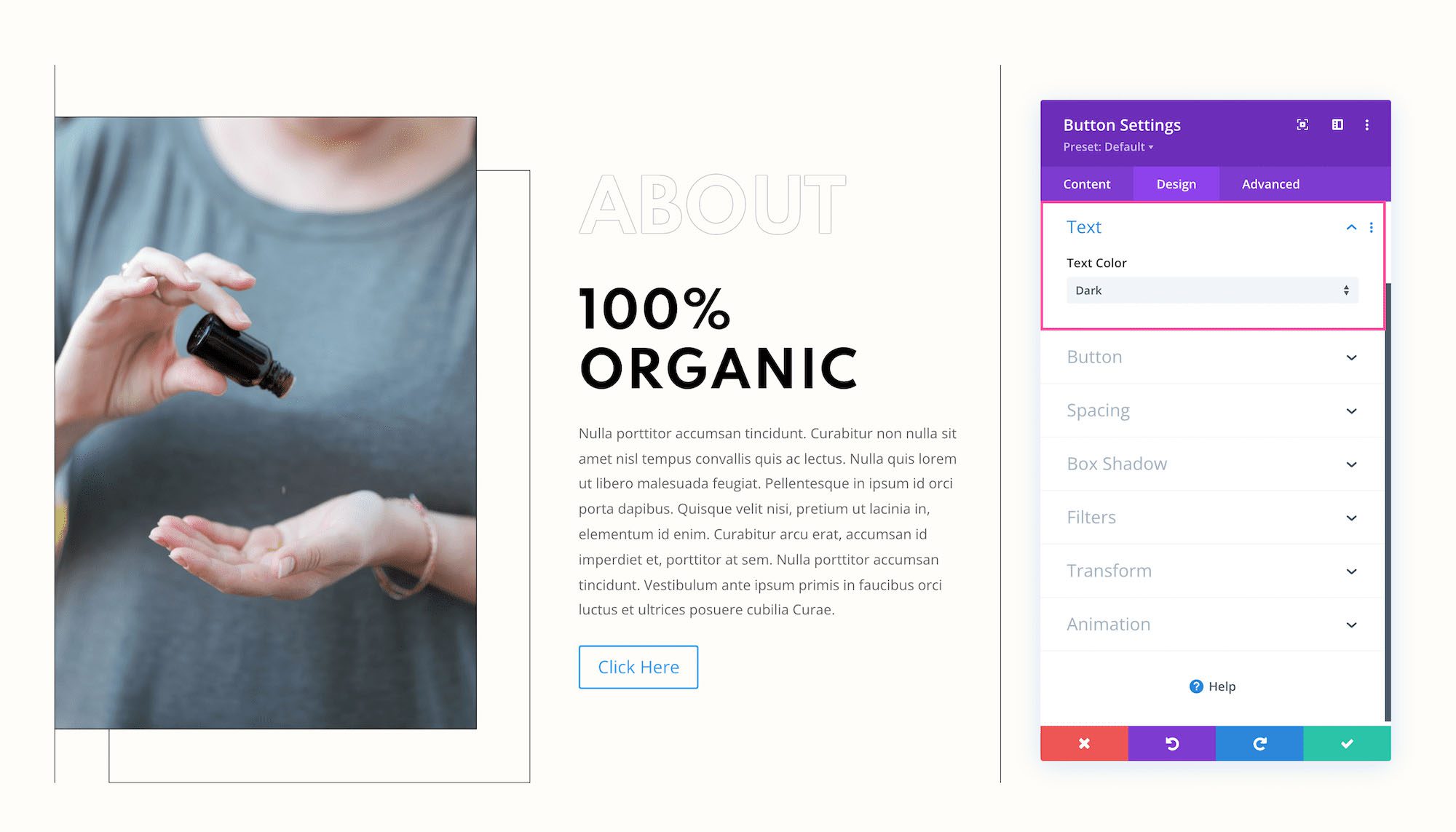
Button
By default, buttons inherit the global design styles set in the WordPress Customizer, however, you can apply custom design styles to buttons here.
- Use Custom Styles For Button – To design a custom style for this button, toggle this option to yes. Then the following options will appear.
- Button Text Size – Choose the size of the button font here. Drag the range slider to adjust the size or type a numerical value in the textbook.
- Button Text Color – Choose the color of the button font here. Select a color from your site’s color palette or use the dropper icon to find a new color.
- Button Background – Choose the background color of the button here. Select a color from your site’s color palette or use the dropper icon to find a new color.
- Button Border Width – Set the button border width here. Drag the range slider to adjust the width or type a numerical value in the textbox.
- Button Border Color – Choose the color of the border here. Select a color from your site’s color palette or use the dropper icon to find a new color.
- Button Border Radius – Set the button’s border radius here. The radius refers to how round the corners are. The higher the number, the more round the corners are. Drag the range slider to adjust the radius or type a numerical value in the textbox.
- Button Letter Spacing – Choose the letter-spacing of the title text by dragging the range slider or by typing in a numerical value. Letter spacing is the space between each individual letter. The higher the number, the more space.
- Button Font – Choose the font you want to use for the button text. The default font is automatically selected; however, you can choose a different font or upload a custom font by clicking the dropdown box.
- Button Font Weight – Click the dropdown to select the boldness of the button font.
- Button Font Style – Choose the style of the button font: italicized, capitalized, small capitals, underlined, or strike-through.
- Show Button Icon – Toggle this option “yes” or “no” to show or hide a button icon.<l/i>
- Button Icon – If the previous option is set to “yes”, you can select the button icon here.
- Button Icon Color – Choose the color of the icon here. Select a color from your site’s color palette or use the dropper icon to find a new color.
- Button Icon Placement – Choose where you want the button icon to be: to the right or left of the button text.
- Only Show Icon On Hover For Button – By default, this option is set to “yes” which means the icon will only appear on hover. If you’d like the icon to always be visible, toggle this option to “no”.
- Button Text Shadow – Here you can apply a drop shadow to the button text. Choose the style of drop shadow you’d like to use and you can customize it using the following options.
- Button Text Shadow Horizontal Length – Adjusts the horizontal positioning of the text shadow.
- Button Text Shadow Vertical Length – Adjusts the vertical positioning of the text shadow.
- Button Text Shadow Blur Strength – Adjusts the shadow blur strength of the shadow applied to the text. The higher the number, the more blur.
- Button Text Shadow Color – Choose the color of the text shadow. Select a color from your site’s color palette or use the dropper icon to find a new color.
Spacing
Here is where you can add margins or spacing to this module by typing in numerical values. Margins add space outside the module element, and padding adds space inside the module element. To lock in ratios and keep the values the same, you can click the chainlink icon between the values you want to always be identical (ex: top and bottom).
Box Shadow
Here you can add a drop shadow to the entire module. Once a shadow style is clicked, you can customize the position of the drop shadow (horizontal and vertical), the strength of the blur, and the spread strength by adjusting the range slider or inputting numerical values. Select the drop shadow’s color from your site’s color palette or click the eyedropper to find a new color. Choose the box-shadow position to be inside the container or outside the container via the dropdown.
Filters
Adjust the hue, saturation, brightness, contrast, color tones (inverted colors or sepia), opacity, and blur of this module. The Blend Mode refers to how the module blends with the layers beneath it. By default, “normal” will be selected.
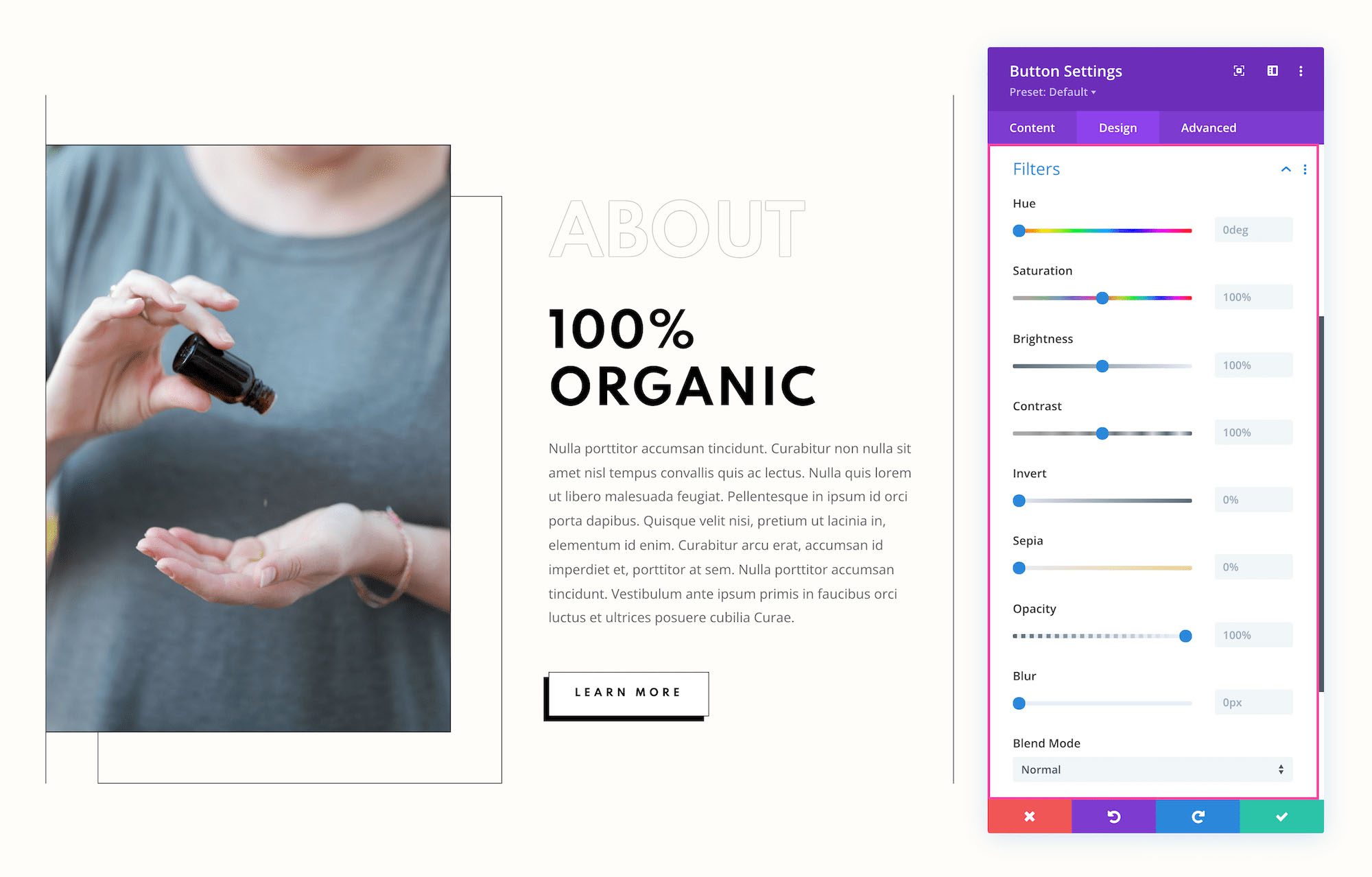
Transform
Scale, translate, rotate, skew, and set origin points for this module. Tab through to access each feature. Configure each feature by inputting numerical values or dragging and expanding the box or circle. You can lock in these values to always be identical by clicking the chain link icon at the bottom right.
Animation
Here you can apply animation to the module. Once you choose an option you can also adjust the duration, delay, opacity, and speed of the animation and whether you want it to continually repeat or just happen once.
Advanced
This is where the advanced customization settings are for the Divi Button module.
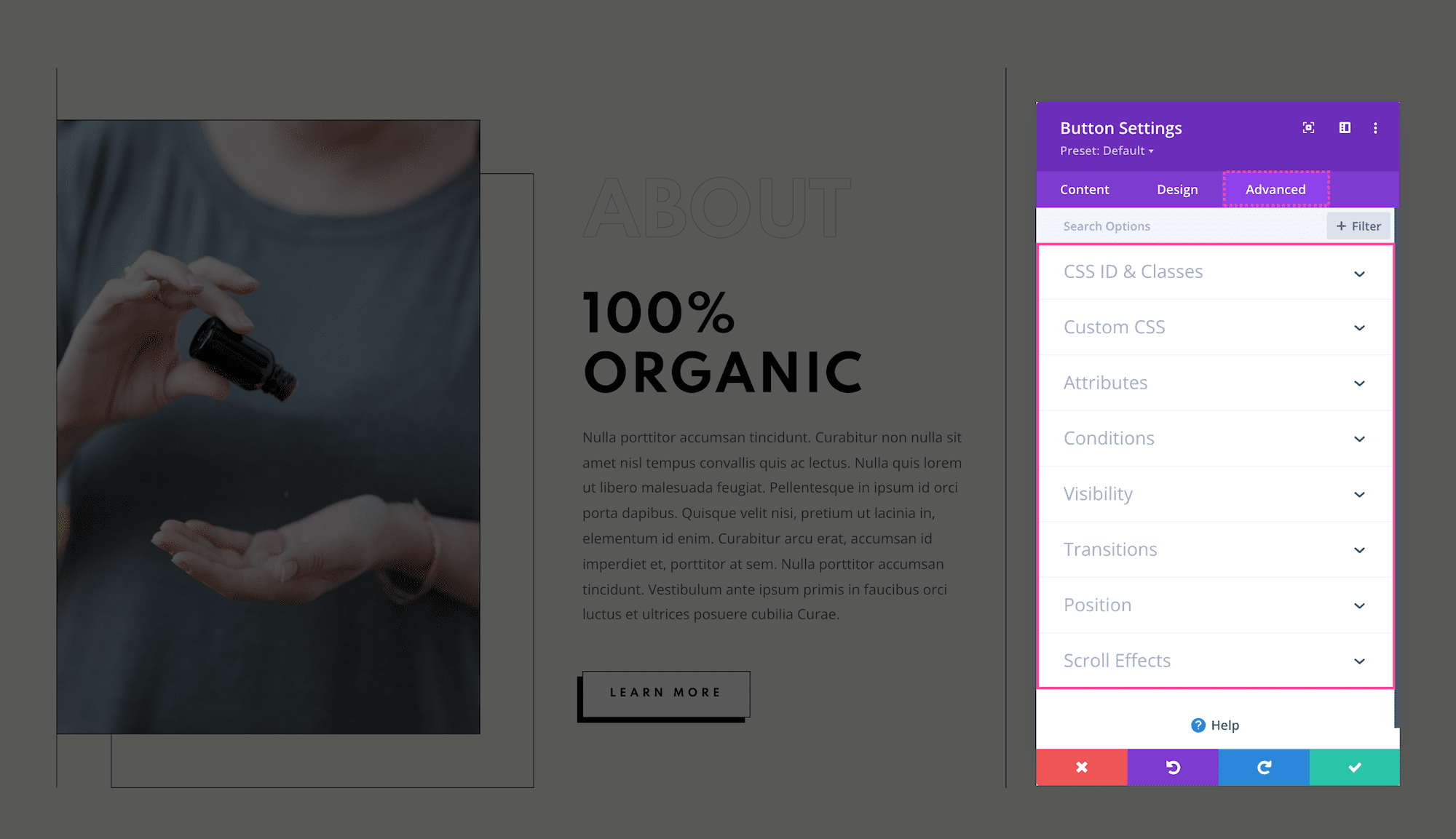
CSS ID & Classes
This is where you can assign a specific CSS ID or class to this module. This is helpful when you’d like to apply custom CSS to a module by using your child theme’s stylesheet.
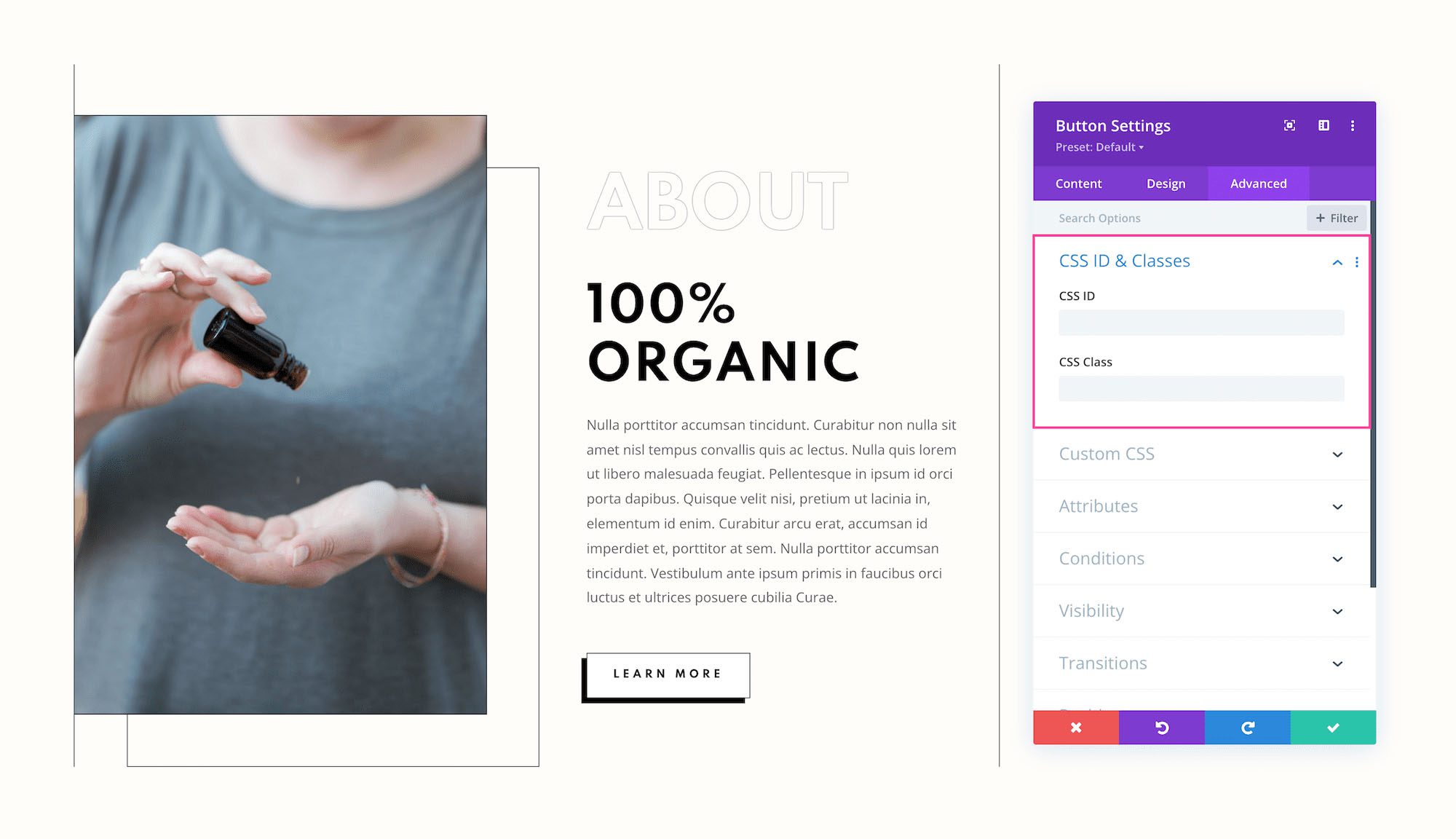
Custom CSS
You can also apply custom CSS to this module by pasting it in this tab. When you click on the Custom CSS tab, you’ll see individual sections where you can add CSS to specific elements in the module.
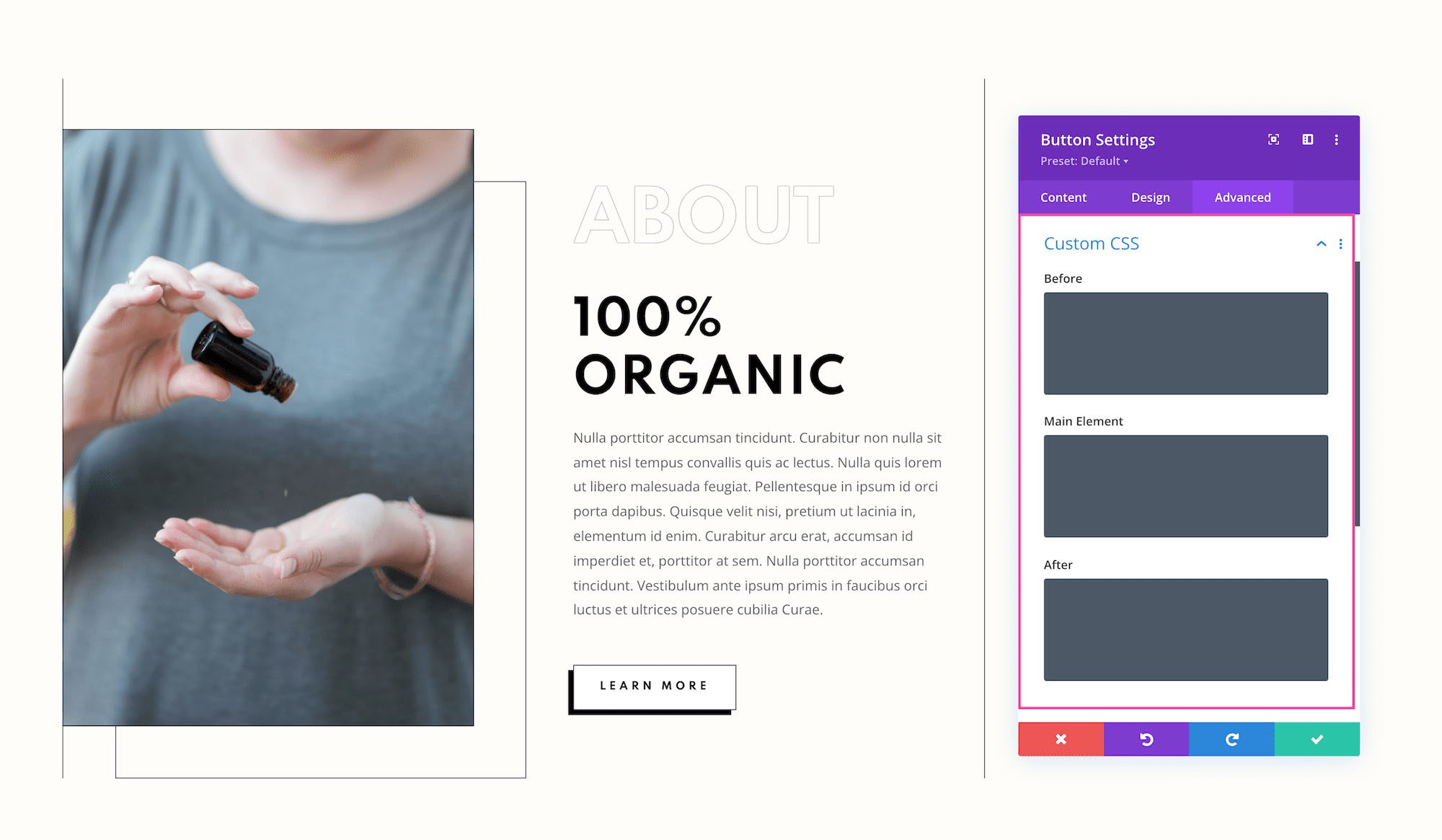
Attributes
Button Relationship – This defines the button link’s relationship between the source you are linking to and the page you are linking from.
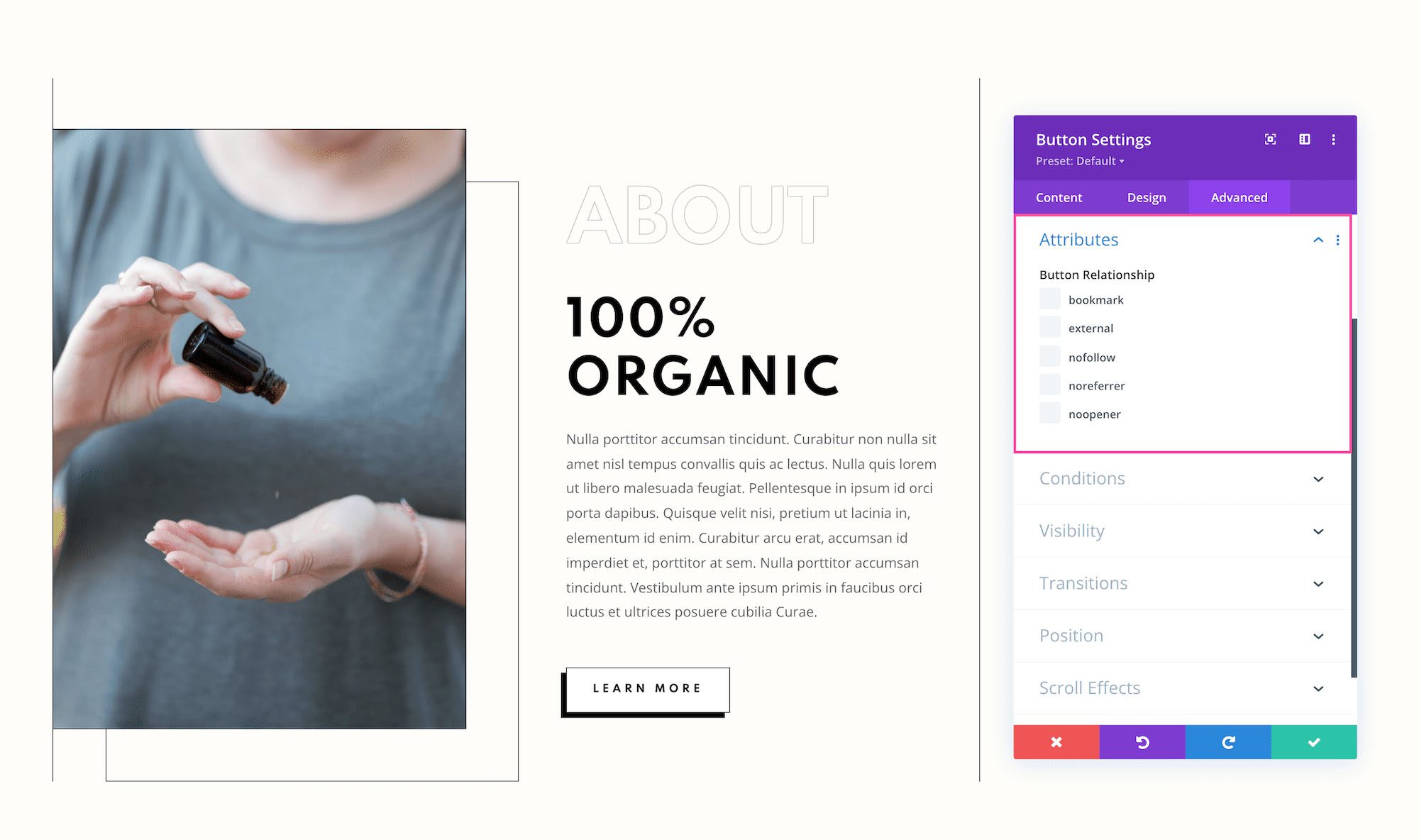
Conditions
This tab allows you to choose when to display this module based on a set of conditions, like what time a user is visiting the page if they’ve already purchased from your company before, what browser they are using, what operating system they’re using, and more. You can add one condition or multiple conditions.
Visibility
This defines the visibility of the module. You can choose to disable it (hide it from view) when the display window is a Phone, Tablet, or Desktop by clicking the corresponding checkbox. You can also determine how you want overflow content to be displayed if the content overflows the element that it is in. You can choose visible, scroll, hidden, or auto for both horizontal and vertical content. By default, “auto” is selected.
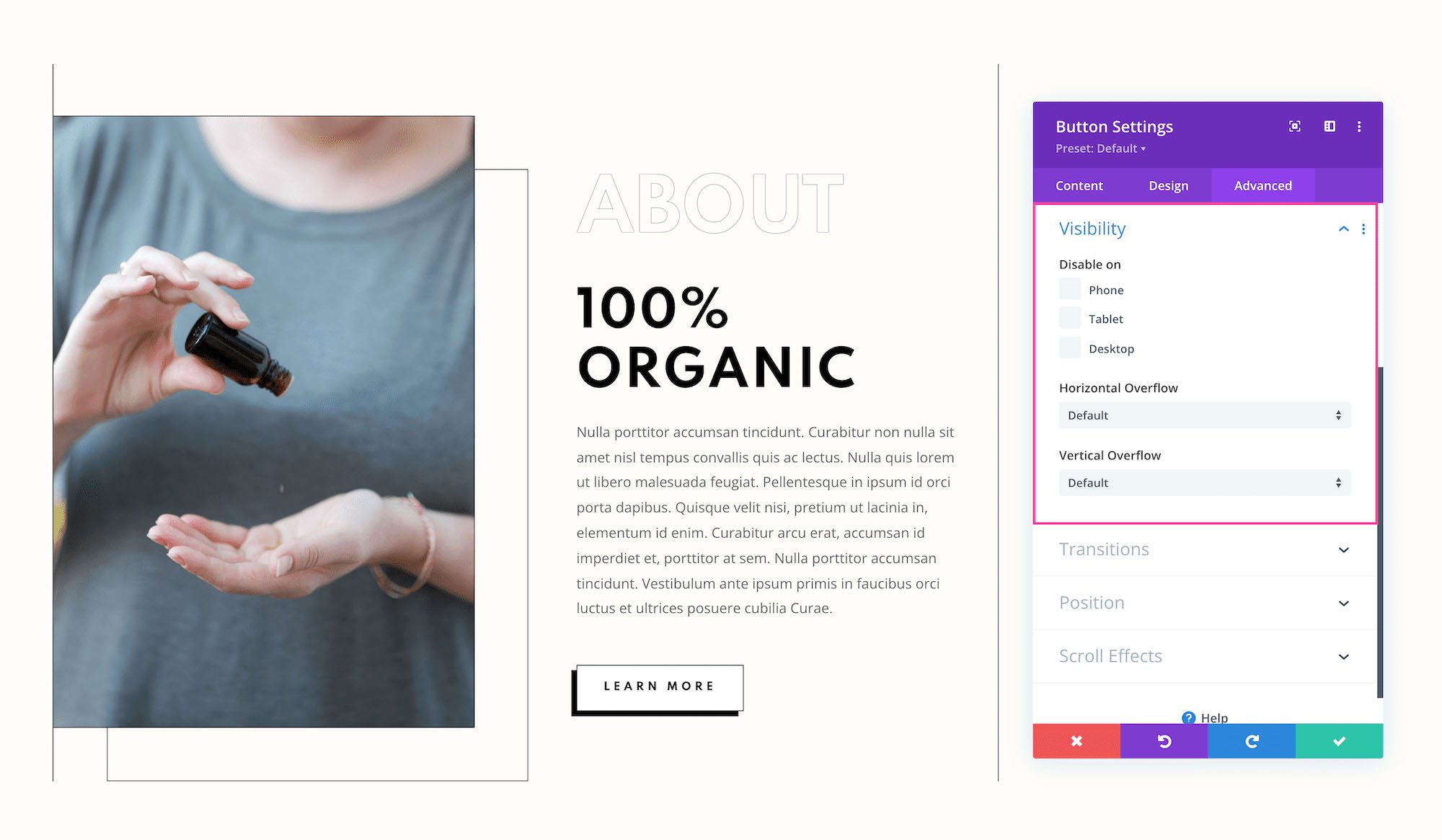
Transitions
This controls the transition duration of the hover animation as well as the delay, and speed curve.
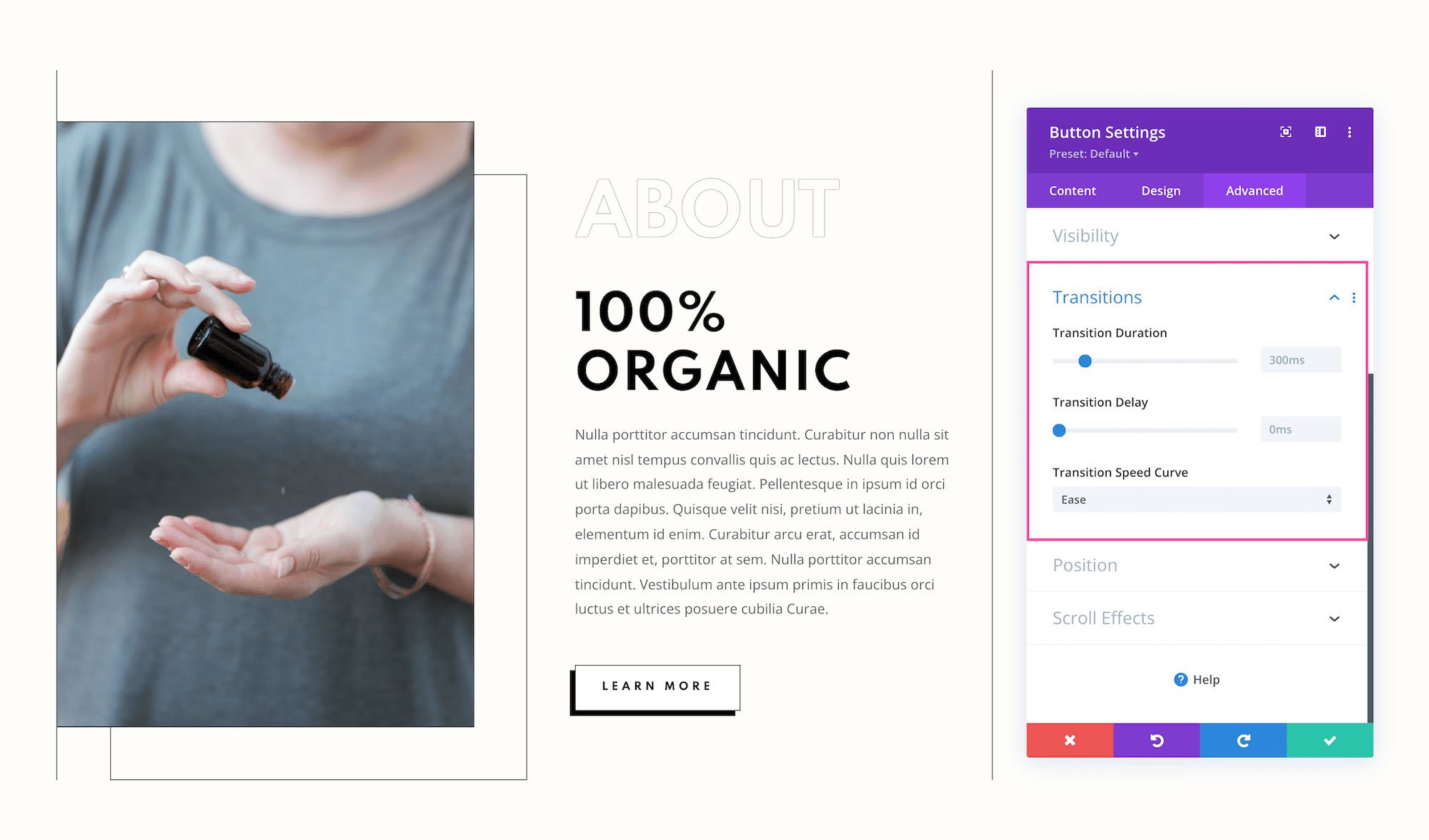
Position
This defines the position of the module as well as the offset origin, vertical and horizontal offsets, and the z-index of the module. The available positions are default (which is automatically selected), relative, absolute, and fixed. Defining the z-index allows you to specify the stack order of elements. Elements with a higher z-index number overlap elements with a lower z-index.
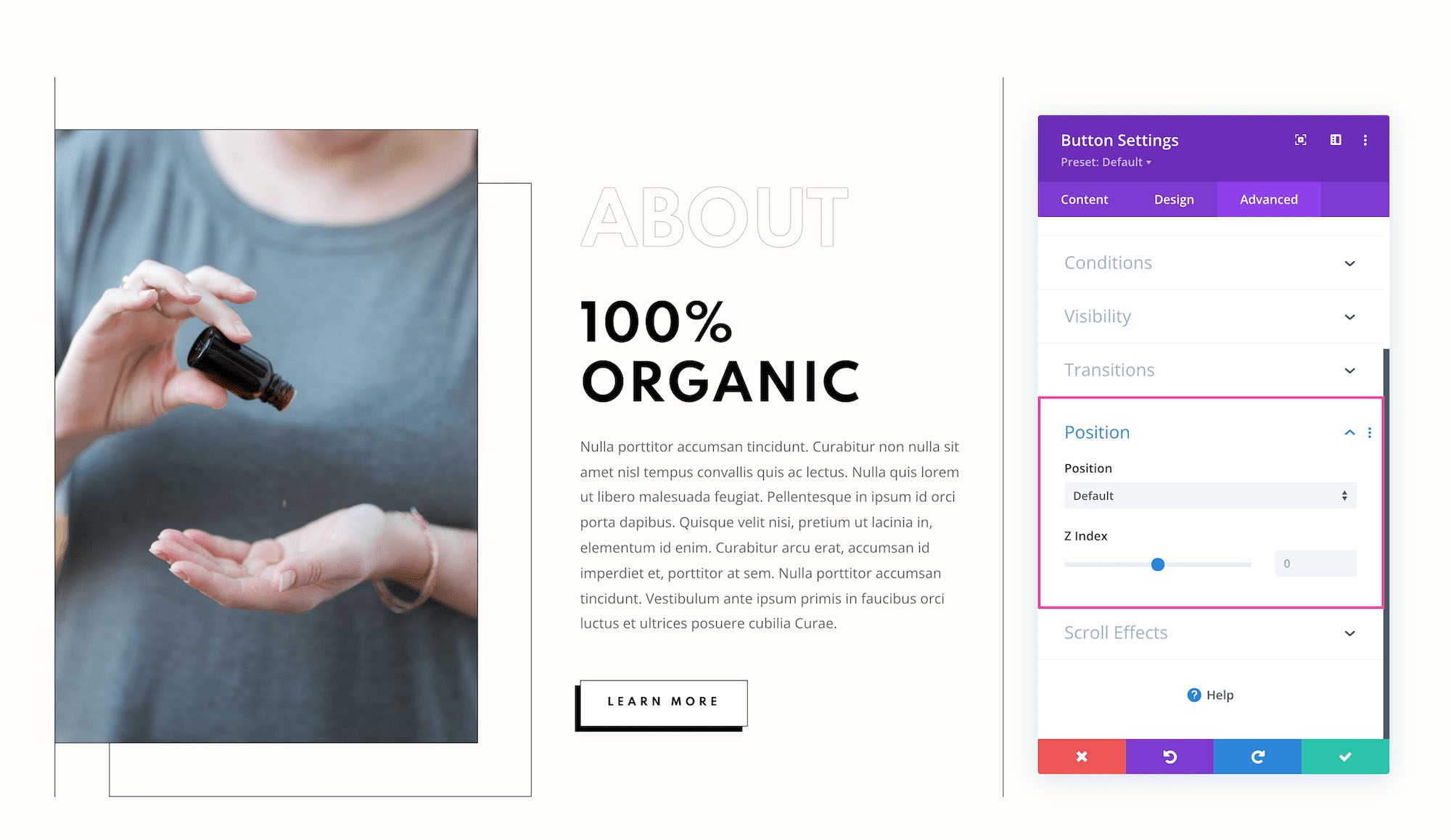
Scroll Effects
This defines how the module behaves upon scroll. You can make the module sticky (to top, bottom, or top and bottom), and choose if the module transforms upon scroll. You can also enable vertical motion on this module which allows you to adjust the speed at which this element scrolls (making it faster or slower) without affecting the surrounding elements. The Motion Trigger Effect allows you to choose when the scroll effect you just applied is triggered: when the top of the element is in view, the middle, or the bottom.
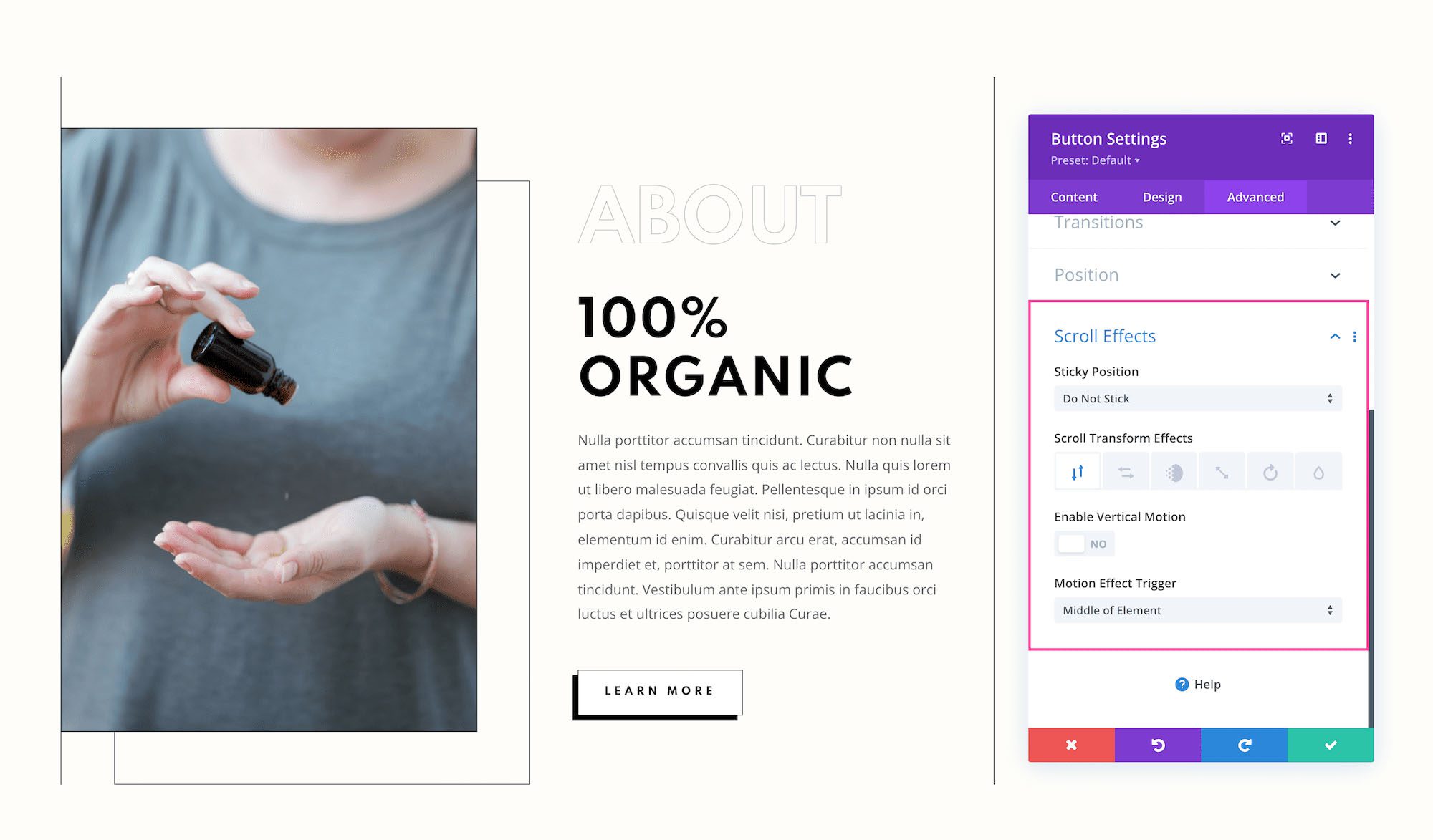
Save Your Design
Once you are finished styling and configuring the module, click the green arrow at the bottom right of the module to save your design. If you close the module without saving, your work will be lost.
Next, Save the Page Design
To save the page design, you can type CMD + S on a Mac or CTRL + S on a PC. You can also use the bottom Divi toolbar to save your page design by clicking the circle purple icon with the three dots “…” to expand the toolbar, and then clicking the green “Save” button at the bottom right.
Exit the Visual Builder
Now that all your changes are saved, click “Exit Visual Builder” on the admin toolbar at the top to exit the Visual Builder.
